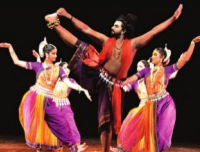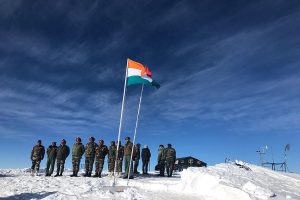In 1908. He was introduced to Kathakali in a Kalari set up in the doorstep of his house under Gurunatha Aasan. Young Gopinath celebrated his Arangetram – first stage appearance – when he was 13. Later he came to be greatly influenced by Vallathol Narayana Menon when he joined Kerala Kalamandalam for higher studies. Subsequently he had partnered Ragini Devi in distant Bombay to showcase the beauty of Kathakali, earning rave reviews.
In 1935, the duo was invited to perform in Santiniketan by Rabindranath Tagore. Guru Gopinath had stayed there for three days. Seeing Guru Gopinath’s innovative style of dance which was deeply rooted to Kathakali, the poet was deeply convinced that this was a style worth looking into. The style fitted into his vision of creating dance movements for his compositions.
Advertisement
Shantideb Ghosh, instrumental in the development of Rabindra Nritya, heard about Kathakali and at the behest of Gurudev visited Vallathol’s Kerala Kalamandalam, where he spent three months and learnt Kathakali Kalasams and a few Hastabhinayas that could be used in the compositions of Tagore. This was the beautiful friendship, exchange and Bengal’s assimilation of Kerala’s performing arts.
Guru Gopinath’s style of dance, which was much later named Kerala Natanam, was taught by Balakrishna Menon, the guru’s talented student, who had made Bengal his home. He was on the faculty of Rabindra Bharati University and was associated with “Children’s Little Theatre” from its formative years. The Artistic Director of Natyanova, Priyadarshini Ghosh had the good fortune of being trained under him. Further exposure of Natyanova to Kerala Natanam happened when Mohana Iyer, Repertory and Co-Director of Natyanova travelled to Trivandrum to imbibe Guru Gopinath’s style of dance. With help from Guruji’s youngest daughter, Vinodini Sasimohan, Rajalakshmi teacher – a direct disciple of Guru Gopinath – taught Mohana the basics – Chuvadugals and two pieces of the legendary guru’s compositions. Thus enriched Natyanova held a lec/dem followed by the repertory members of Natyanova presenting chuvadugals and tirmanams of the Guru Gopinath style and presented Vasantutsavam, one of the great guru’s earliest compositions, which used to be performed by Thankamani Gopinath – his dance and life partner – who was well versed in Mohiniattam and Guru Gopinath’s style of dance. This was followed by Mandira Dance – a composition of Balakrishna Menon. Sparsh Studios was the venue. In spite of torrential rains interested people braved the weather to be present for this memorable event.
Odissi performer-teacher Odissi dancer Madhulita Mohapatra who has made Bangalore her adopted home, where she runs her school Nrityantar, recently celebrated a mega festival showcasing her qualities as a teacher. She herself has been schooled under Guru Gangadhar Pradhan and his ace pupil Aruna Mohanty. She has also taken the trouble of learning Guru Kelucharan Mohapatra’s style of Odissi dance.
She chose to make her students open their innings with a dance piece based on verses written by Sanskrit scholar Pandit Nityananda Mishra, “Divya Kshetra Jagabbath Puri Dham” extolling the qualities of Lord Jagannath in Puri. The piece described the Jagannath temple as the crest jewel of all temples, adorned with Nilachakra (the blue discus) at the top , mounted with the flag called Patita Pavana (the purifier of the fallen). Nilachakra is the most revered iconic symbol signifying Lord Jagannath’s blessings and protection. Everything about the temple, to its last detail was described. It was almost like a guided tour of the temple through Odissi dance.
Music of the piece was set to ragas Kirwani and tala Ektali. Madhulita Mohapatra is a stickler for making her students perfect in the nritya elements, which is why her students performed Pallavis in various ragas in the festival. ‘Sajani’ choreographed by Madhulita was a true confession of a Sakhi to Radha about Krishna’s sad state of mind in her absence. The imagery of the lyric was expressed beautifully.
Composer Binod Bihari Panda’s music resonated in the minds of the people for a long time. Jayadeva’s famous astapadi ‘Dhira Samira’ showed wrathful Radha hurt when her beloved Krishna enjoys affectionate moments with other gopis oblivious of her existence. In this astapadi with a deep message where the sakhi takes on the role of Radha’s mentor and helps her to unite with the supernatural soul of Krishna has been well defined. Dance composed by Madhulita was performed with subtlety of expression by Paridhi Joshi. It was breathless in its beauty.
‘Dekhago Radha Madhava Chali’ based on the poem of 17th century poet Shri Banamali Das that expressed the joy of devotees on seeing the eternal lovers together was presented by the talented duo Angeleena Avni and Prisha Sinha. Meghna Das, a seasoned dancer, presented a piece where she portrayed Yashoda as a mother harassed by her over-active mischievous son.
A mortal mother has practical problems and naturally asks her immortal son for all kinds of explanations. Uthilu ede begi kahinki re, a traditional Odiya poem, set to music by Shri Binod Panda, had dance choreography by Sahana Das . The abhinaya piece was emoted most touchingly. Shiva Dhimahi – a group dance by the repertory members of Nrityantar paid tribute to the Lord of dance, Nataraja. Nataraja’s matted locks holding river Ganga and wearing the moon crescent on his head was described in the Odissi vocabulary. Other miracles of Shiva were eloquently described too. The tandava dance of Shiva was shown in all its glory. The rhythm of the piece was uniquely created by Guru Dhaneswar Swain. Music composition was by Sukanta Kundu. Script and inputs by Pandit Shri Nityananda Mishra gave the piece its richness.
Dance chorography was again by Madhulita Mohapatra. Dayanand Akilesh, K Reddy, Tara Ramakrishnan, Leah Rachel & Kriti Sengupta mesmerized the audience. Darbari Pallavi presented in polished Odissi dance was a pleasure to watch. Anjali Raj Urs, Sahana Raghavendra Maiya and Nandhana Shashikumar were the performers. Hari Smarane Mado in praise of Lord Vishnu is based on the popular devarnama, Hari Smarane Mado Niranthara by Purandhara Dasa, urging constant meditatation of Hari to get salvation to redeem oneself. Popular stories where devotees have sought shelter under the protection of Hari were enacted to an appreciative audience.
Dancers Srudhi KV, Mini Somakumar, Dr. Anupama Kumar, SwetapadmaMishra, Madhurima Chakraborty, Rajitha Shekhar and Gayatri Atchanta were all senior disciples of Madhulita who performed the dance.
It was a beautiful evening. Aficionados savored stories from our great mythology and legends of past days. But what we missed was the link ingof our great past to contemporary thoughts and secular topics.











